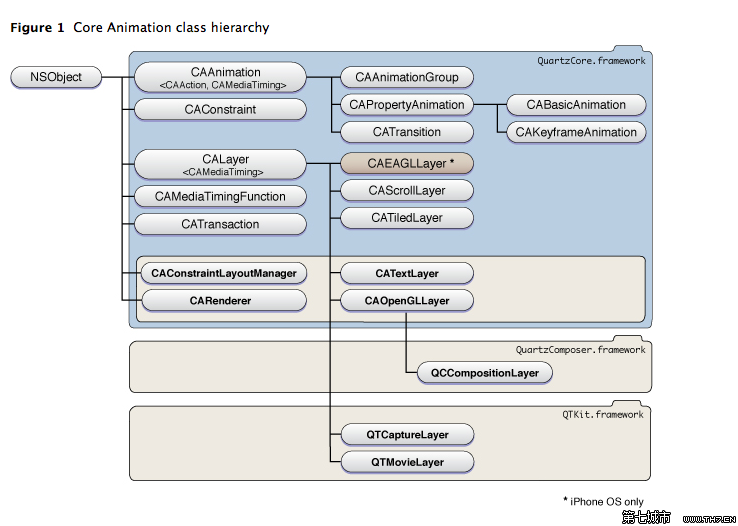与动画有关的几个类的继承关系

涉及到动画的类主要有6个,看一下它们的基本用途:
1. CAAnimation
动画基类
2. CAAnimationGroup
组合多个动画
3. CAPropertyAnimation
CAPropertyAnimation is an abstract subclass of CAAnimation for creating animations that manipulate the value of layer properties. The property is specified using a key path that is relative to the layer using the animation.
就如它的名字,CAPropertyAnimation是针对layer的某个property来进行动画的,比如position等。
4. CATransition
The CATransition class implements transition animations for a layer. You can specify the transition effect from a set of predefined transitions or by providing a custom CIFilter instance.
CATransition能够为层提供移出以及移入屏幕的效果,有了这个,就可以省去复杂的编码了,不过只提供了有限的几种动画。其实它的效果,都可以用自己写的动画代码实现。
5. CABasicAnimation
CABasicAnimation provides basic, single-keyframe animation capabilities for a layer property. You create an instance of CABasicAnimation using the inherited animationWithKeyPath: method, specifying the key path of the property to be animated in the render tree.
这个animationWithKeyPath: method是CAPropertyAnimation中的方法,在这个子类中,仅仅多了3个属性(fromValue,toValue,byValue),以便使创建CAPropertyAnimation更简单。
6. CAKeyframeAnimation
The CAKeyframeAnimation class provides keyframe animation capabilities for a layer object. You create an CAKeyframeAnimation object using the inherited animationWithKeyPath: method, specifying the key path of the property that you want to animate on the layer. You can then specify the keyframe values to use to control the timing and animation behavior.
CABasicAnimation是一个最多只能有两个(?不是一个)关键帧的动画,而CAKeyframeAnimation除了可含有多个关键帧,而且还可以修改每个关键帧的速度。什么叫做keyframe 动画呢?一个keyframe就相当于你指定了一组确定的数据,表明了frame的显示属性,CABasicAnimation其实只需要我们提供开始和结束时的显示属性,其他的显示帧都由系统自动生成,所以keyframe就2个,动画比较单一。而CAKeyframeAnimation不同,它有2种方法指定多个keyframe:一种是指定path属性,一种是指定values属性,注意If you specify a value for path property, any data in the values property is ignored.
这里有一篇关于CAKeyframeAnimation动画的文章,感谢作者!http://blog.csdn.net/huifeidexin_1/article/details/8504075
这里还有msdn中的关于关键帧动画的讲解,中文版!http://msdn.microsoft.com/zh-cn/library/cc189038(v=vs.95).aspx
今天在写程序时,想写一个图片绕着圆运动的动画,于是用了CAKeyframeAnimation,但是我初始化时用的是[CAKeyframeAnimation animation] 而不是[CAKeyframeAnimation animationWithKeyPath:@"position"],查了好久查出了问题,在这里总结一下。
第一个[CAKeyframeAnimation animation] 是CAAnimation的方法,而animationWithKeyPath是 CAPropertyAnimation的方法。这里的keypath 指的是 The key path of the property to be animated. 就是要被动画的属性的key path。如果你不明白什么是objective-c 的key path ,请查看objective-c 的kvc相关介绍。
再看一下CAKeyframeAnimation的path属性,这个属性是CAKeyframeAnimation自己的属性,不是继承来的,它的作用是For layer properties that contain a CGPoint data type, the path object you assign to this property defines the values for that property over the length of the animation. 就是说,如果你在[CAKeyframeAnimation animationWithKeyPath:@"position"]方法中用到了以CGPoint做类型的属性,比如CALayer的position属性,那么就可以用path值指定动画过程中的各个GCPoint值。
所以说,如果仅仅使用[CAKeyframeAnimation animation],并不指定CAPropertyAnimation的keyPath,那么所返回的animation对象就不知道如何利用path的值来产生动画,自然就不可能动了。当然如果你在[CAKeyframeAnimation animation]得到动画后,利用animation.keyPath = @"position"; 指定了keyPath,那么程序也是正确的。
总结,如果使用CAKeyframeAnimation,或CABasicAnimation 那么对keyPath的赋值是必须的!
除了使用CAAnimation类和子类外,还可以使用CATransaction,它的特点是:可以同时对多个layer的属性进行动画。
1.禁止CALayer的动画效果
When you change the property of a layer, Core Animation usually creates an implicit transaction object to animate the change. If you do not want to animate the change, you can disable implicit animations by creating an explicit transaction and setting itskCATransactionDisableActions property to true.
简单的说,就是对CALayer的属性做修改,系统默认是会有动画效果的,如果不想使用动画效果,需要使用下面的代码:
[CATransaction begin]; [CATransaction setValue:(id)kCFBooleanTrue forKey:kCATransactionDisableActions]; [aLayer removeFromSuperlayer]; [CATransaction commit];
2.使用CATransaction的优点
One of the main reasons to use transactions is that within the confines of an explicit transaction, you can change the duration, timing function, and other parameters. You can also assign a completion block to the entire transaction so that your app can be notified when the group of animations finishes.
就是能更改layer动画默认属性,添加完成后的监听。比如,以下代码更改了动画的执行时间:
[CATransaction begin]; [CATransaction setValue:[NSNumber numberWithFloat:10.0f] forKey:kCATransactionAnimationDuration]; // Perform the animations [CATransaction commit];
使用CAAnimation和CATransaction的区别在哪里?
首先,CATransaction可以同时对多个layer的属性进行动画。
另外,我们看看layer中的函数 - (void)addAnimation:(CAAnimation *)anim forKey:(NSString *)key,它的描述是 Add the specified animation object to the layer’s render tree.
由此,我们可以看出,使用animation方式添加动画,是在layer的render tree 中添加动画,没有改动layer tree 和 representation tree( representation tree 不会被更改??好像会更改),表现就是:动画过完成后,layer又回到了原始的位置;而如果通过CATransaction实现动画,就会更改layer tree。
这里还有一篇好文章,感谢作者! http://blog.sina.com.cn/s/blog_7c45221901014ezr.html